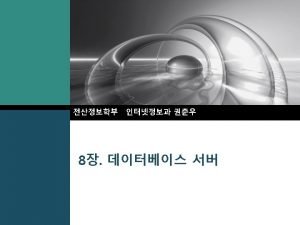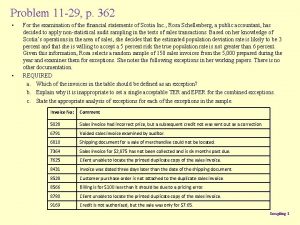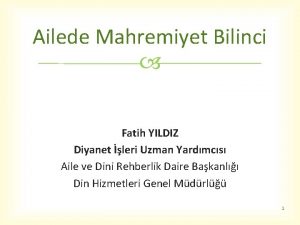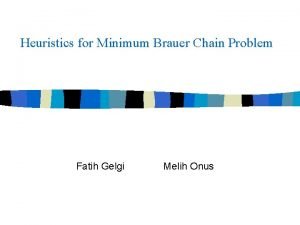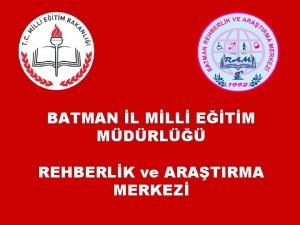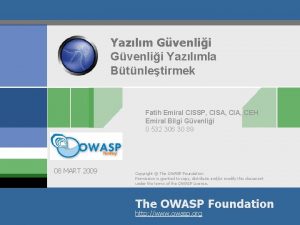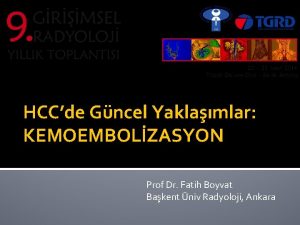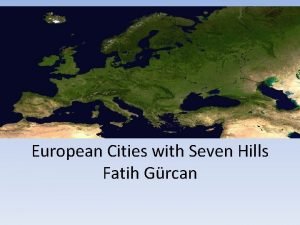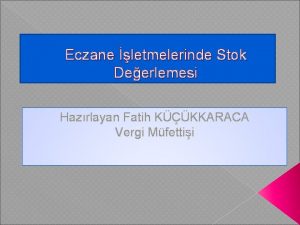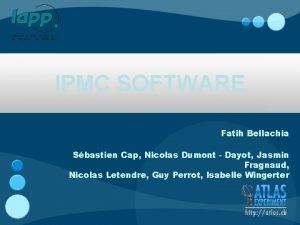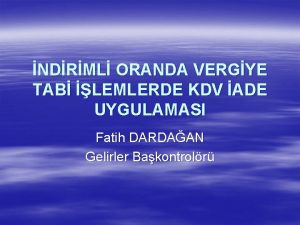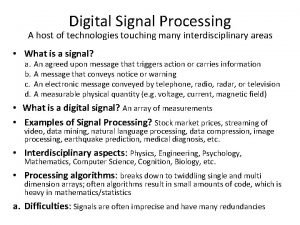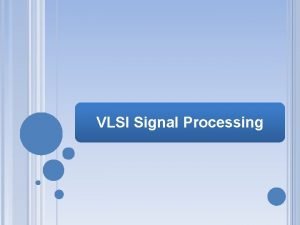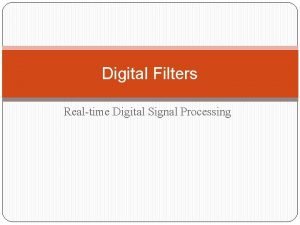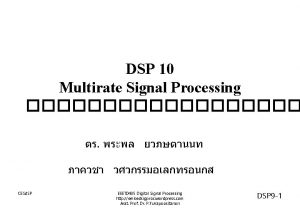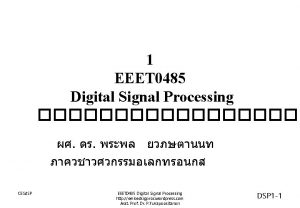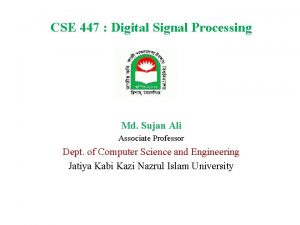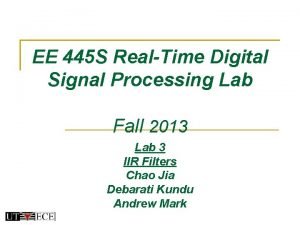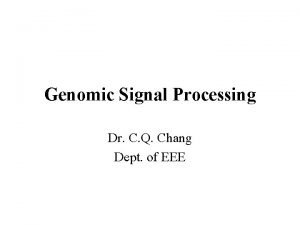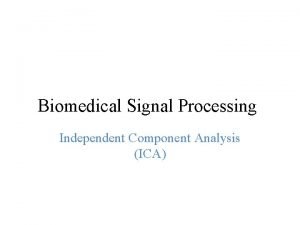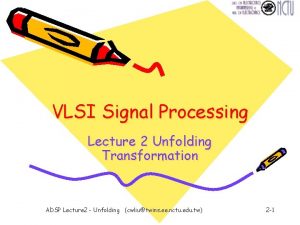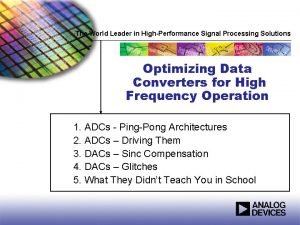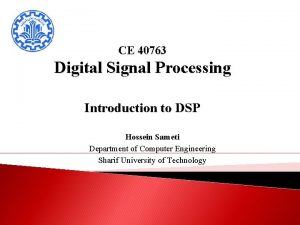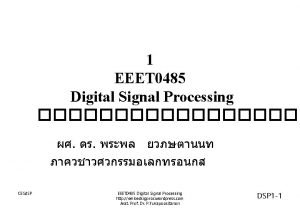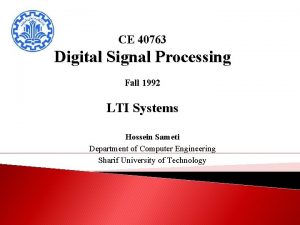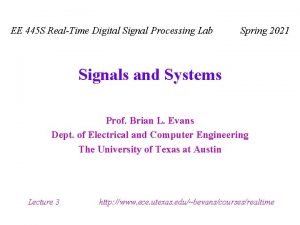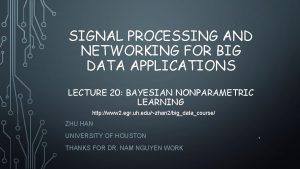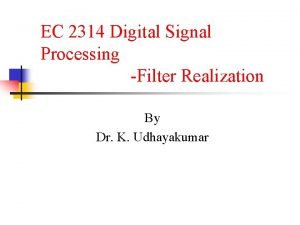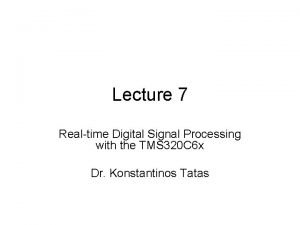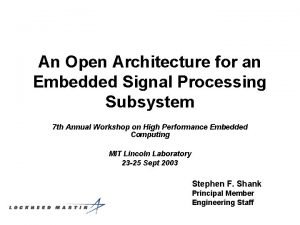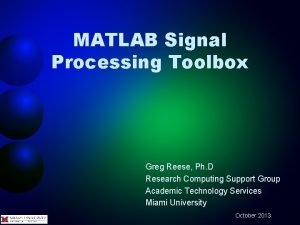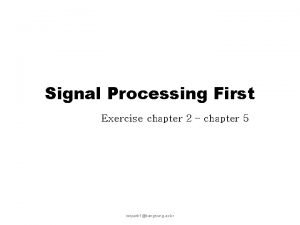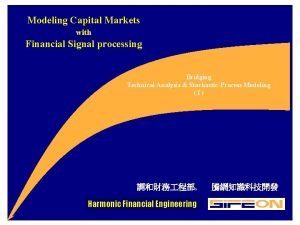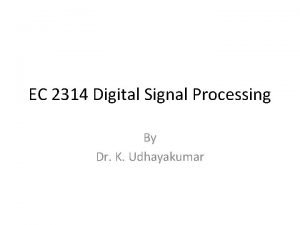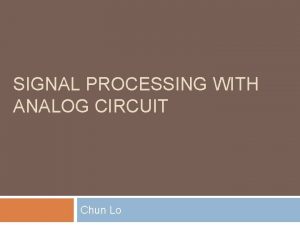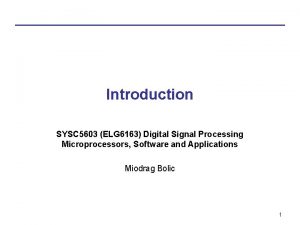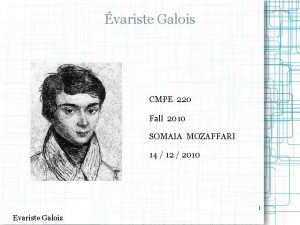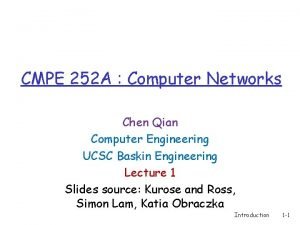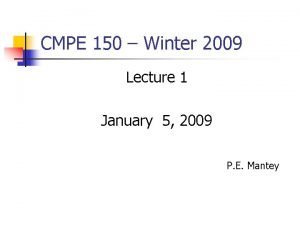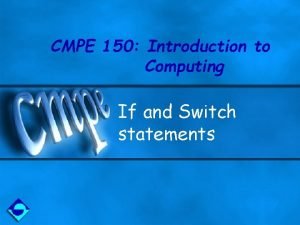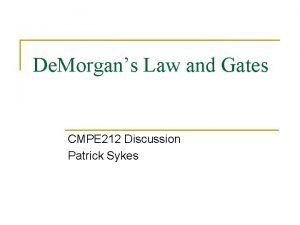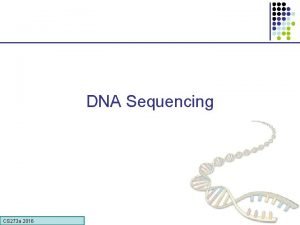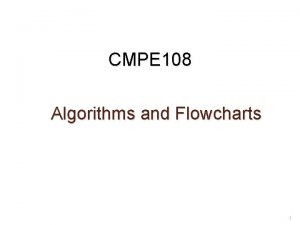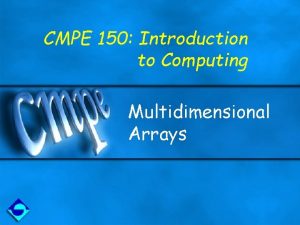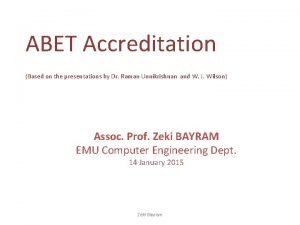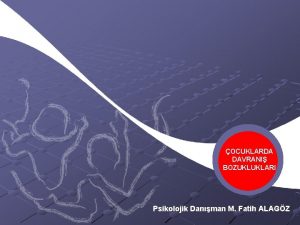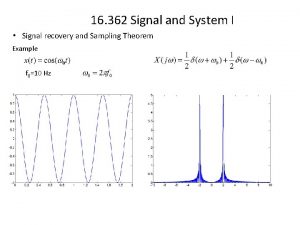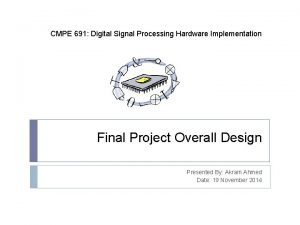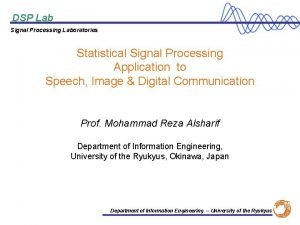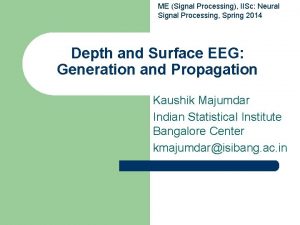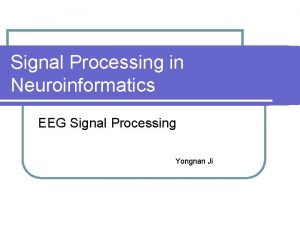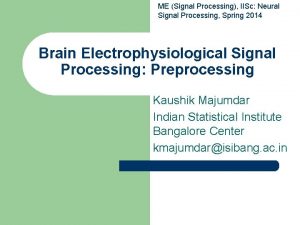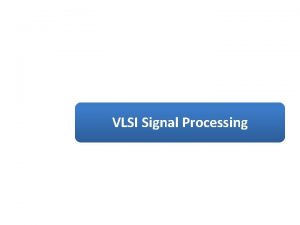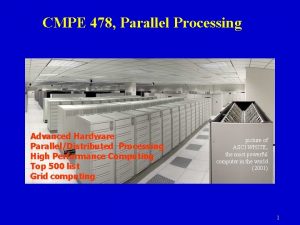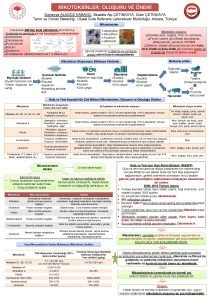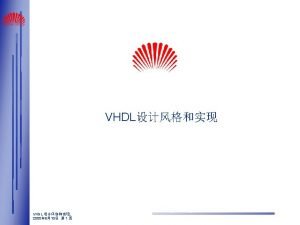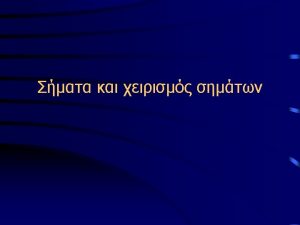cmpe 362 Signal Processing Instructor Fatih Alagz Assistant
























![DIGITIZE the WAVEFORM § x[n] is a SAMPLED SINUSOID § A list of numbers DIGITIZE the WAVEFORM § x[n] is a SAMPLED SINUSOID § A list of numbers](https://slidetodoc.com/presentation_image_h2/c8012bd19e2033fd13818cb4b80ef658/image-25.jpg)
![STORING DIGITAL SOUND § x[n] is a SAMPLED SINUSOID § A list of numbers STORING DIGITAL SOUND § x[n] is a SAMPLED SINUSOID § A list of numbers](https://slidetodoc.com/presentation_image_h2/c8012bd19e2033fd13818cb4b80ef658/image-26.jpg)











































- Slides: 69

cmpe 362 - Signal Processing Instructor: Fatih Alagöz Assistant: Yekta Sait Can

What is Signal? § Signal is the variation of a physical phenomenon / quantity with respect to one or more independent variable § A signal is a function. Example 1: Voltage on a capacitor as a function of time. + RC circuit 2

What is Signal? Example 2: Two different vocoder signals of “Otuz yedi derece” male/female, emotion, background noise, any aspects of vocoder functionallity. Have you had something spicy, salty, sour just before you say it; function of everything !!! 3

What is Signal? Example 3 : Closing value of the stock exchange index as a function of days Example 4: Image as a function of x-y coordinates (e. g. 256 X 256 pixel image) Index MT W T F S S Fig. Stock exchange 4

What is Signal Processing §Process signal(s) for solving many scientific/ engineering/ theoretical purposes §The process is includes calculus, Differential equations, Difference equations, Transform theory, Linear time-invariant system theory, System identification and classification, Time-frequency analysis, Spectral estimation, Vector spaces and Linear algebra, Functional analysis, statistical signals and stochastic processes, Detection theory, Estimation theory, Optimization, Numerical methods, Time series, Data mining, etc §“The IEEE Transactions on Signal Processing covers novel theory, algorithms, performance analyses and applications of techniques for the processing, understanding, learning, retrieval, mining, and extraction of information from signals. The term "signal" includes, among others, audio, video, speech, image, communication, geophysical, sonar, radar, medical and musical signals. Examples of topics of interest include, but are not limited to, information processing and theory and application of filtering, coding, transmitting, estimating, detecting, analyzing, recognizing, synthesizing, recording, and reproducing signals” REFERENCE: IEEE Transactions on Signal Processing Journal 5

Signal Processing everywhere x(n) or x(t) INPUT SIGNAL § § § § § y(n) or SYSTEM (PROCESS)y(t) OUTPUT SIGNAL Audio, speech, image, video Ranging from nanoscale to deepspace communications Sonar, radar, geosensing Array processing, Control systems (all industry) Seismology, Meteorology, Finance, Health, etc. . IT IS GOOD TO KNOW THIS COURSE 6

I am currently working on gender classification problem for chicken hatchery eggs DİŞİ FTIR (Fourier Transform Infrared Spectrometer) yöntemi ile allantoik sıvının kimyasal bileşenine (östrojen seviyesi gibi) duyarlı frekans bandındaki (kırmızı bant) ışığın soğurulma oranına dayalı olarak yumurtadaki östrojen miktarı yumurtaya zarar vermeden (uzaktan) saptanabilir. ERKEK 7

The course in a single slide 8

ALL ABOUT THREE DOMAINS Use H(z) to get Freq. Response TIME-DOMAIN 10/16/2021 9 Z-TRANSFORM-DOMAIN: poles & zeros POLYNOMIALS: H(z) FREQ-DOMAIN

Lets start from the beginning. . . Signals… 10

Signal Processing First LECTURE #1 Sinusoids

READING ASSIGNMENTS § This Lecture: § Chapter 2, Sects. 2 -1 to 2 -5 § Appendix A: Complex Numbers § Appendix B: MATLAB § Chapter 1: Introduction 10/16/2021 2003 rws/j. Mc 12

LECTURE OBJECTIVES § Write general formula for a “sinusoidal” waveform, or signal § From the formula, plot the sinusoid versus time § What’s a signal? § It’s a function of time, x(t) § in the mathematical sense 10/16/2021 2003 rws/j. Mc 13

TUNING FORK EXAMPLE § § § CD-ROM demo “A” is at 440 Hertz (Hz) Waveform is a SINUSOIDAL SIGNAL Computer plot looks like a sine wave This should be the mathematical formula: 10/16/2021 2003 rws/j. Mc 14

SINUSOID AMPLITUDE EXAMPLES 1 -)0. 25*sin(2π*300 t) 2 -)0. 50*sin(2π*300 t) 3 -)1. 00*sin(2π*300 t) Different Amplitude Sound Examples Amplitude = Asin(2π*300 t) Amplitude = 5*Asin(2π*300 t) 10/16/2021 Amplitude =10*A sin(2π*300 t) 15

SINUSOID FREQUENCY EXAMPLES 1 -)1. 00 sin(2π*300 t) 2 -)1. 00*sin(2π*600 t) 3 -)1. 00*sin(2π*1200 t) Different Amplitude Sound Examples Amplitude = 1. 00 sin(2π*300 t) Amplitude = 1. 00 sin(2π*600 t) 10/16/2021 Amplitude = 1. 00 sin(2π*1200 t) 16

SINUSOID PHASE EXAMPLES 1 -)1. 00 sin(2π*300 t) 2 -)1. 00*sin(2π*300 t+ π/2) 3 -)1. 00*sin(2π*300 t+ π) 10/16/2021 17

HUMAN VOICE WITH DIFFERENT SAMPLING FREQUENCIES ØWith the original sampling frequency Fs ØWhen sampled with Fs/2 ØWhen sampled with 2*Fs ØWhen sampled with 5*Fs 10/16/2021 18

TIME VS FREQUENCY REPRESENTATION OF ONE CLAP RECORD(SPECTROGRAM) 10/16/2021 19

TIME VS FREQUENCY REPRESENTATION OF TWO CLAPS RECORD (SPECTROGRAM) 10/16/2021 20

TIME VS FREQUENCY REPRESENTATION OF CLAP + SNAP RECORD (SPECTROGRAM) (FIRST CLAP THEN FINGER SNAP) 10/16/2021 21

TUNING FORK A-440 Waveform Time (sec) 10/16/2021 2003 rws/j. Mc 22

SPEECH EXAMPLE § More complicated signal (BAT. WAV) § Waveform x(t) is NOT a Sinusoid § Theory will tell us § x(t) is approximately a sum of sinusoids § FOURIER ANALYSIS § Break x(t) into its sinusoidal components § Called the FREQUENCY SPECTRUM 10/16/2021 2003 rws/j. Mc 23

Speech Signal: BAT § Nearly Periodic in Vowel Region § Period is (Approximately) T = 0. 0065 sec 10/16/2021 2003 rws/j. Mc 24
![DIGITIZE the WAVEFORM xn is a SAMPLED SINUSOID A list of numbers DIGITIZE the WAVEFORM § x[n] is a SAMPLED SINUSOID § A list of numbers](https://slidetodoc.com/presentation_image_h2/c8012bd19e2033fd13818cb4b80ef658/image-25.jpg)
DIGITIZE the WAVEFORM § x[n] is a SAMPLED SINUSOID § A list of numbers stored in memory § Sample at 11, 025 samples per second § Called the SAMPLING RATE of the A/D § Time between samples is § 1/11025 = 90. 7 microsec § Output via D/A hardware (at Fsamp) 10/16/2021 2003 rws/j. Mc 25
![STORING DIGITAL SOUND xn is a SAMPLED SINUSOID A list of numbers STORING DIGITAL SOUND § x[n] is a SAMPLED SINUSOID § A list of numbers](https://slidetodoc.com/presentation_image_h2/c8012bd19e2033fd13818cb4b80ef658/image-26.jpg)
STORING DIGITAL SOUND § x[n] is a SAMPLED SINUSOID § A list of numbers stored in memory § § CD rate is 44, 100 samples per second 16 -bit samples Stereo uses 2 channels Number of bytes for 1 minute is § 2 X (16/8) X 60 X 44100 = 10. 584 Mbytes 10/16/2021 2003 rws/j. Mc 26

SINUSOIDAL SIGNAL § FREQUENCY § Radians/sec § Hertz (cycles/sec) § PERIOD (in sec) 10/16/2021 § AMPLITUDE § Magnitude § PHASE 2003 rws/j. Mc 27

EXAMPLE of SINUSOID § Given the Formula § Make a plot 10/16/2021 2003 rws/j. Mc 28

PLOT COSINE SIGNAL § Formula defines A, w, and f 10/16/2021 2003 rws/j. Mc 29

PLOTTING COSINE SIGNAL from the FORMULA § Determine period: § Determine a peak location by solving § Zero crossing is T/4 before or after § Positive & Negative peaks spaced by T/2 10/16/2021 2003 rws/j. Mc 30

PLOT the SINUSOID § Use T=20/3 and the peak location at t=-4 10/16/2021 2003 rws/j. Mc 31

PLOTTING COSINE SIGNAL from the FORMULA § Determine period: § Determine a peak location by solving § Peak at t=-4 10/16/2021 © 2003, JH Mc. Clellan & RW Schafer 33

ANSWER for the PLOT § Use T=20/3 and the peak location at t=-4 10/16/2021 © 2003, JH Mc. Clellan & RW Schafer 34

TIME-SHIFT § In a mathematical formula we can replace t with t-tm § Then the t=0 point moves to t=tm § Peak value of cos(w(t-tm)) is now at t=tm 10/16/2021 © 2003, JH Mc. Clellan & RW Schafer 35

TIME-SHIFTED SINUSOID 10/16/2021 © 2003, JH Mc. Clellan & RW Schafer 36

PHASE <--> TIME-SHIFT § Equate the formulas: § and we obtain: § or, 10/16/2021 © 2003, JH Mc. Clellan & RW Schafer 37

SINUSOID from a PLOT § Measure the period, T § Between peaks or zero crossings § Compute frequency: w = 2 p/T 3 steps § Measure time of a peak: tm § Compute phase: f = -w tm § Measure height of positive peak: A 10/16/2021 © 2003, JH Mc. Clellan & RW Schafer 38

(A, w, f) from a PLOT 10/16/2021 © 2003, JH Mc. Clellan & RW Schafer 39

SINE DRILL (MATLAB GUI) 10/16/2021 © 2003, JH Mc. Clellan & RW Schafer 40

PHASE § The cosine signal is periodic § Period is 2 p § Thus adding any multiple of 2 p leaves x(t) unchanged 10/16/2021 © 2003, JH Mc. Clellan & RW Schafer 41

COMPLEX NUMBERS § To solve: z 2 = -1 §z=j § Math and Physics use z = i § Complex number: z = x + j y y z x 10/16/2021 © 2003, JH Mc. Clellan & RW Schafer Cartesian coordinate system 42

PLOT COMPLEX NUMBERS 10/16/2021 © 2003, JH Mc. Clellan & RW Schafer 43

COMPLEX ADDITION = VECTOR Addition 10/16/2021 © 2003, JH Mc. Clellan & RW Schafer 44

*** POLAR FORM *** § Vector Form § Length =1 § Angle = q § Common Values § j has angle of 0. 5 p § -1 has angle of p § - j has angle of 1. 5 p § also, angle of -j could be -0. 5 p = 1. 5 p -2 p § because the PHASE is AMBIGUOUS 10/16/2021 © 2003, JH Mc. Clellan & RW Schafer 45

POLAR <--> RECTANGULAR § Relate (x, y) to (r, q) Most calculators do Polar-Rectangular Need a notation for POLAR FORM 10/16/2021 © 2003, JH Mc. Clellan & RW Schafer 46

Euler’s FORMULA § Complex Exponential § Real part is cosine § Imaginary part is sine § Magnitude is one 10/16/2021 © 2003, JH Mc. Clellan & RW Schafer 47

COMPLEX EXPONENTIAL § Interpret this as a Rotating Vector § § 10/16/2021 q = wt Angle changes vs. time ex: w=20 p rad/s Rotates 0. 2 p in 0. 01 secs © 2003, JH Mc. Clellan & RW Schafer 48

cos = REAL PART Real Part of Euler’s General Sinusoid So, 10/16/2021 © 2003, JH Mc. Clellan & RW Schafer 49

REAL PART EXAMPLE Evaluate: Answer: 10/16/2021 © 2003, JH Mc. Clellan & RW Schafer 50

COMPLEX AMPLITUDE General Sinusoid Complex AMPLITUDE = X Then, any Sinusoid = REAL PART of Xejwt 10/16/2021 © 2003, JH Mc. Clellan & RW Schafer 51

Z DRILL (Complex Arith) 10/16/2021 © 2003, JH Mc. Clellan & RW Schafer 52

AVOID Trigonometry § Algebra, even complex, is EASIER !!! § Can you recall cos(q 1+q 2) ? (q +q ) j 1 2 § Use: real part of e = cos(q +q ) 1 10/16/2021 © 2003, JH Mc. Clellan & RW Schafer 2 53

Euler’s FORMULA § Complex Exponential § Real part is cosine § Imaginary part is sine § Magnitude is one 10/16/2021 © 2003, JH Mc. Clellan & RW Schafer 54

Real & Imaginary Part Plots PHASE DIFFERENCE 10/16/2021 = p/2 © 2003, JH Mc. Clellan & RW Schafer 55

COMPLEX EXPONENTIAL § Interpret this as a Rotating Vector § § 10/16/2021 q = wt Angle changes vs. time ex: w=20 p rad/s Rotates 0. 2 p in 0. 01 secs © 2003, JH Mc. Clellan & RW Schafer 56

Rotating Phasor See Demo on CD-ROM Chapter 2 10/16/2021 © 2003, JH Mc. Clellan & RW Schafer 57

Cos = REAL PART Real Part of Euler’s General Sinusoid So, 10/16/2021 © 2003, JH Mc. Clellan & RW Schafer 58

COMPLEX AMPLITUDE General Sinusoid = REAL PART of (Aejf)ejwt Complex AMPLITUDE = X 10/16/2021 © 2003, JH Mc. Clellan & RW Schafer 59

POP QUIZ: Complex Amp § Find the COMPLEX AMPLITUDE for: § Use EULER’s FORMULA: 10/16/2021 © 2003, JH Mc. Clellan & RW Schafer 60

WANT to ADD SINUSOIDS § ALL SINUSOIDS have SAME FREQUENCY § HOW to GET {Amp, Phase} of RESULT ? 10/16/2021 © 2003, JH Mc. Clellan & RW Schafer 61

ADD SINUSOIDS § Sum Sinusoid has SAME Frequency 10/16/2021 © 2003, JH Mc. Clellan & RW Schafer 62

PHASOR ADDITION RULE Get the new complex amplitude by complex addition 10/16/2021 © 2003, JH Mc. Clellan & RW Schafer 63

Phasor Addition Proof 10/16/2021 © 2003, JH Mc. Clellan & RW Schafer 64

POP QUIZ: Add Sinusoids § ADD THESE 2 SINUSOIDS: § COMPLEX ADDITION: 10/16/2021 © 2003, JH Mc. Clellan & RW Schafer 65

POP QUIZ (answer) § COMPLEX ADDITION: § CONVERT back to cosine form: 10/16/2021 © 2003, JH Mc. Clellan & RW Schafer 66

ADD SINUSOIDS EXAMPLE tm 1 tm 2 tm 3 10/16/2021 © 2003, JH Mc. Clellan & RW Schafer 67

Convert Time-Shift to Phase § Measure peak times: § tm 1=-0. 0194, tm 2=-0. 0556, tm 3=-0. 0394 § Convert to phase (T=0. 1) § f 1=-wtm 1 = -2 p(tm 1 /T) = 70 p/180, § f 2= 200 p/180 § Amplitudes § A 1=1. 7, A 2=1. 9, A 3=1. 532 10/16/2021 © 2003, JH Mc. Clellan & RW Schafer 68

Phasor Add: Numerical § Convert Polar to Cartesian § X 1 = 0. 5814 + j 1. 597 § X 2 = -1. 785 - j 0. 6498 § sum = § X 3 = -1. 204 + j 0. 9476 § Convert back to Polar § X 3 = 1. 532 at angle 141. 79 p/180 § This is the sum 10/16/2021 © 2003, JH Mc. Clellan & RW Schafer 69

ADD SINUSOIDS X 1 VECTOR (PHASOR) ADD 10/16/2021 X 3 X 2 © 2003, JH Mc. Clellan & RW Schafer 70
 Imab 362
Imab 362 Ksql logo
Ksql logo P 362
P 362 Rheolube 362
Rheolube 362 Ece 362
Ece 362 Ece 362
Ece 362 Ece 362
Ece 362 Classification of signals
Classification of signals Baseband signal and bandpass signal
Baseband signal and bandpass signal Baseband signal and bandpass signal
Baseband signal and bandpass signal Digital signal as a composite analog signal
Digital signal as a composite analog signal Anlam bilimsel hatalar
Anlam bilimsel hatalar Ailede mahremiyet bilinci
Ailede mahremiyet bilinci Fatih gelgi
Fatih gelgi Batman fatih anadolu lisesi taban puanı
Batman fatih anadolu lisesi taban puanı Fatih zeyveli
Fatih zeyveli Cissp nedir
Cissp nedir Mustafa uckun los angeles
Mustafa uckun los angeles Fatih kaan tuncer
Fatih kaan tuncer Fatih boyvat
Fatih boyvat European capital built on seven hills
European capital built on seven hills Fatih talu
Fatih talu Kuran tilavetinde yaygın hatalar
Kuran tilavetinde yaygın hatalar Fatih ugurdag
Fatih ugurdag Frenleme radyasyonu
Frenleme radyasyonu Fatih uckun
Fatih uckun Fatih küçükkaraca
Fatih küçükkaraca Nicolas
Nicolas Fatih dardağan
Fatih dardağan Akçadağ fatih fen lisesi
Akçadağ fatih fen lisesi Digital signal processing
Digital signal processing Parallel system tsample ---- tclock
Parallel system tsample ---- tclock Digital image processing
Digital image processing Super audio cd
Super audio cd Digital signal processing
Digital signal processing Digital signal processing
Digital signal processing Digital signal processing
Digital signal processing Genomic signal processing
Genomic signal processing Ica signal processing
Ica signal processing Unfolding in vlsi signal processing
Unfolding in vlsi signal processing Signal processing solutions
Signal processing solutions Digital signal processing
Digital signal processing Digital signal processing
Digital signal processing Digital signal processing
Digital signal processing What is dsp
What is dsp Signal processing for big data
Signal processing for big data Type of structure
Type of structure High-performance digital signal processing
High-performance digital signal processing Dsp
Dsp Open architecture radar
Open architecture radar Signal processing toolbox matlab
Signal processing toolbox matlab Signal processing first
Signal processing first Roc in z transform
Roc in z transform Financial signal processing
Financial signal processing Digital signal processing
Digital signal processing Precision analog signal processing
Precision analog signal processing Asic form 5603
Asic form 5603 Variste galois
Variste galois Cmpe 280
Cmpe 280 Qian chen ucsc
Qian chen ucsc Cmpe 280
Cmpe 280 Cmpe 150
Cmpe 150 Cmpe 150
Cmpe 150 Cmpe 212
Cmpe 212 Cmpe 280
Cmpe 280 Cs 273
Cs 273 Cmpe 280
Cmpe 280 Pseudocode flowchart example
Pseudocode flowchart example Cmpe150
Cmpe150 Dr abet
Dr abet

